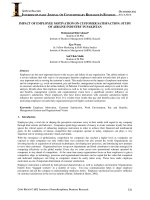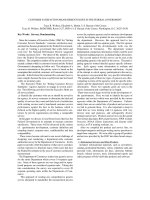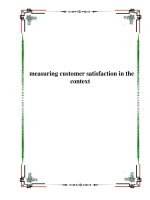MODELLING IMPORTANCE PREFERENCES IN CUSTOMER SATISFACTION SURVEYS
Bạn đang xem bản rút gọn của tài liệu. Xem và tải ngay bản đầy đủ của tài liệu tại đây (434.23 KB, 18 trang )
MODELLING IMPORTANCE PREFERENCES IN CUSTOMER
SATISFACTION SURVEYS
E. Grigoroudis
(1)
, Y.Politis
(1)
, O. Spyridaki
(1)
and Y. Siskos
(2)
,
(1)
Technical University of Crete
Decision Support Systems Laboratory
University Campus, 73100 Chania, Greece
Tel. +30-8210-37346 / Fax +30-8210-64824
Email:
(2)
University of Piraeus
Department of Informatics
Karaoli Dimitriou 80, 18534 Piraeus, Greece
Tel. +30-10-4142260 / Fax +30-10-4142264
Email:
ABSTRACT
Customer satisfaction measurement, through MUSA model, provides the analysts with the
highest and lowest performance indicators, pointing out the leverage opportunities and the
weaknesses of the company. An extension of the MUSA methodology for modelling customer
importance preferences for service characteristics is presented in this paper. Several approaches
in the context of multiobjective linear programming are examined, which give the ability to
compare derived and modelled weights of the satisfaction dimensions and to introduce the
principles of Kano’s model to MUSA methodology. Finally, the results of an application of the
MUSA extension to an educational organization are presented in this paper.
Key words: Customer satisfaction analysis, MUSA method, Satisfaction importance modelling,
Kano’s model.
1. INTRODUCTION
To reinforce customer orientation on a day-to-day basis, a growing number of companies
choose customer satisfaction as their main performance indicator. However, customer
satisfaction must be translated into a number of measurable parameters directly linked to several
aspects of a company’s products/services or else it will remain an abstract and intangible notion.
Measurement will provide the analysts with the highest and lowest performance indicators,
pointing out the leverage opportunities and the weaknesses of the company.
It often happens that derived importance by a preference disaggregation model differs from the
stated importance. By the term stated importance we refer to the importance that is given to
each criterion by the customers. It is not unreasonable to say that customers tend to rate every
criterion as important, when asked freely (Naumann and Giel, 1995).
The aim of this paper is to present an extension of the MUSA methodology that helps modelling
customer importance preferences for service characteristics. This approach gives the ability to
compare derived and modelled weights of the satisfaction dimensions and to extrapolate
valuable results. The results of an application of the MUSA extension to an educational
organization, give an example of the differentiation between derived and stated importance.
This paper is organised in 4 sections. Section 2 presents briefly the mathematical background of
importance preferences modeling. Here are presented the basic principles of Kano’s model and
1
MUSA method, as well as a summary description of customers’ preferences importance
modelling with MUSA. The main results of the application for the customers of an educational
organization are presented in section 3. Section 4 summarizes some concluding remarks, along
with the basic advantages of the MUSA extension.
2. DIFFERENT METHODOLOGICAL APPROACHES FOR CUSTOMER
SATISFACTION
2.1. Kano’s model for customer satisfaction
In many cases customer satisfaction has been seen mostly as a one-dimensional construction –
the higher the perceived product quality, the higher the customer’s satisfaction and vice versa.
But fulfilling the individual product/service requirements to a great extent does not necessarily
imply a high level customer satisfaction. It is also the type of requirement which defines the
perceived product/service quality and thus customer satisfaction. A characteristic example of
this situation is the assessment of customer satisfaction for a pen point (Vavra, 1997). If the
flow of the ink is not sufficient (or it is more than needed), customers will state a high level of
dissatisfaction. On the other hand, if the flow of the ink is sufficient, it is possible that the
customers will not state a high level of satisfaction, considering that the particular attribute is a
necessary and expected feature of the product.
In his model (see figure 1), Kano (1984) distinguishes between three types of product/service
requirement which influence customer satisfaction in different ways when met. Based on the
Kano model, it can be recognized that customer satisfaction is more than one-level issue as
traditionally viewed. It may not be enough to merely satisfy customers by meeting their basic
and spoken requirements under current highly competitive environments. One main reason is
that nowadays there are so many similar products for customers to choose from in the
marketplace. The three types of product/service requirements in the Kano model are (Kano
1984):
Must-be requirements
The must be requirements are basic criteria of a product/service. If these requirements are not
fulfilled, the customer will be extremely dissatisfied. On the other hand, as the customer takes
these requirements for granted, their fulfillment will not increase his satisfaction. Fulfilling the
must-be requirements will only lead to a state of “not dissatisfied”. The customer regards the
must-be requirements as prerequisites, he takes them for granted and therefore does not
explicitly demand them. Must-be requirements are in any case a decisive competitive factor, and
if they are not fulfilled, the customer will not be interested in the product/service at all.
One dimensional requirements
With regard to these requirements, customer satisfaction is proportional to the level of
fulfillment – the higher the level of fulfillment, the higher the customer’s satisfaction and vice
versa. One-dimensional requirements are usually explicitly demanded by the customer.
Attractive requirements
These requirements are the product/service criteria which have the greatest influence on how
satisfied a customer will be with a given product/service. Attractive requirements are neither
explicitly expressed nor expected by the customer. Fulfilling these requirements leads to more
than proportional satisfaction. If they are not met, however, there is no felling of dissatisfaction.
It must be noticed that the specific classification of customer requirements to one of the above
categories is dynamic and affected from the competitiveness of the market. Thereby, an
attractive attribute of a product/service may in a short time become one-dimensional or even
expected attribute.
2
Customer satisfied
Customer dissatisfied
Requirement
fulfilled
Requirement
not fulfilled
Must-be requirements
- implied
- self-evident
- not expressed
- obvious
Attractive requirements
- not expressed
- customer-tailored
- cause delight
One dimensional
requirements
- articulated
- specified
- measurable
- technical
Source: Berger et al., 1993
Figure 1: Kano’s model of customer satisfaction
The advantages of classifying customer requirements by means of the Kano method are very
clear (Matzler et al., 1996, Matzler and Hinterhuber, 1998):
• Product requirements are better understood: the product/service criteria which have the
greatest influence on the customer’s satisfaction can be identified. Classifying
product/service requirements into must-be, one dimensional and attractive dimensions can
be used to focus on.
• Priorities for product development. It is, for example, not very useful to invest in improving
must-be requirements which are already at a satisfactory level but better to improve one-
dimensional or attractive requirements as they have a greater influence on perceived
product/service quality and consequently on the customer’s level of satisfaction.
• Kano’s method provides valuable help in trade-off situations in the product development
stage. If two product requirements cannot be met simultaneously due to technical or
financial reasons, the criterion which has the greatest influence on customer satisfaction can
be identified.
• Must-be, one-dimensional and attractive requirements differ, as a rule, in the utility
expectations of different customer segments. From this starting point, customer-tailored
solutions for special problems can be elaborated which guarantee an optimal level of
satisfaction in the different customer segments.
• Discovering and fulfilling attractive requirements creates a wide range of possibilities for
differentiation. A product which merely satisfies the must-be and one-dimensional
3
requirements is perceived as average and therefore interchangeable (Hinterhuber et al.,
1994).
• Kano’s model of customer satisfaction can be optimally combined with quality function
deployment. A prerequisite is identifying customer needs, their hierarchy and priorities
(Griffin and Hauser, 1993). Kano’s model is used to establish the importance of individual
product/service features for the customer’s satisfaction and thus it creates the optimal
prerequisite for process-oriented product development activities.
2.2 Satisfaction and customer loyalty
There have been extensive studies about the linkage between satisfaction and customer loyalty.
As many researchers suggest, customer loyalty is a combination of both behaviours and
attitudes (Dick and Basu, 1994; Oliver 1996; Allen and Rao, 2000; Jacoby, 1978). This means
that loyal customers are those who have a favourable attitude and repeated purchases as well.
Oliver (1996) defines loyalty as a strong commitment of customers that will repeat the purchase
or will continue to be customers of a product or a service in the future, no matter what the
impact of various situations or the efforts of marketing that aims to the change of customers’
purchase behaviour are. In most cases, customer satisfaction is a necessary but not sufficient
condition for loyalty. Satisfaction is directed specifically at product/service characteristics, and
may be relatively more dynamic measure. In contrast, customer loyalty is a broaden, more static
attitude toward a company in general, and it may include both rational and emotional elements.
In any case, it is generally accepted that loyalty is affected by customer satisfaction in direct or
indirect way (Vavra, 1997; Oliver 1996; Allen and Rao, 2000).
There are several types of loyalty according to the market conditions or the customer attachment
toward a product/service. Furthermore, different levels of customer loyalty exist in relation to
the degree of positive commitment (Hill, 1996). The most common acceptable measures of
loyalty are customer retention (repurchase intention) and willingness to recommend the
product/service to other consumers.
Of much interest is the work of Oliva et al. (1992, 1995) were there is an attempt to study and
analyse the correlation of customer loyalty with customer satisfaction, by using the basic
principles of catastrophe theory.
3. THE MUSA METHOD (Grigoroudis and Siskos, 2002)
The MUSA model is based on the principles of multicriteria analysis, using ordinal regression
techniques. The main objective of the MUSA method is the aggregation of individual judgments
into a collective value function via a linear programming disaggregation formulation. The
assumption is made that client’s global satisfaction depends on a set of criteria or variables
representing service characteristic dimensions.
According to the model, each customer is asked to express his/her preferences, namely his/her
global satisfaction and his/her satisfaction with regard to the set of discrete criteria. MUSA
assesses global and partial satisfaction functions Υ
*
and Χ
i
*
respectively, given customers’
judgments Υ
and Χ
i
. The method follows the principles of ordinal regression analysis under
constraints using linear programming techniques (Jacquet-Lagrèze and Siskos, 1982; Siskos and
Yannacopoulos, 1985; Siskos, 1985). The ordinal regression analysis equation has the following
form (Table 1 presents model variables):
4
=
=
∑
∑
=
=
1
1
1
n
i
i
n
i
*
ii
*
b
XbY
(1)
where the value functions
Y
and are normalised in the interval [0, 100], and is the
weight of the i-th criterion.
*
*
i
X
i
b
Table 1: Variables of the MUSA method
Y
: client’s global satisfaction
α
: number of global satisfaction levels
y
m
: the m-th global satisfaction level (m=1, 2, ...,
α
)
n
: number of criteria
X
i
: client’s satisfaction according to the i-th criterion (i=1, 2, …,
n
)
α
i
: number of satisfaction levels for the i-th criterion
x
i
k
: the k-th satisfaction level of the i-th criterion (k=1, 2, ...,
α
i
)
Y
*
: value function of
Y
y
*m
: value of the
y
m
satisfaction level
X
*
i
: value function of
X
i
x
i
*k
: value of the
x
i
k
satisfaction level
The normalisation constraints can be written as follows:
==
==
,n,,i=x,x
y,y
i
*α
ii
*α*
…21 for 100 0
100 0
1*
1
(2)
Furthermore, because of the ordinal nature of
Y
and the following preference conditions
are assumed:
i
X
−=⇔≤
−=⇔≤
++
++
121 for
121
11
11
i
k
i
k
i
k*
i
k*
i
mmm*m*
,α,,kxxxx
,α,,myyyy
…≺
…≺
for
(3)
where
≺
means “less preferred or indifferent to”.
The MUSA method infers an additive collective value function
, and a set of partial
satisfaction functions from customers’ judgements. The main objective of the method is to
achieve the maximum consistency between the value function
Υ and the customers’
judgements Υ .
*
Υ
*
*
i
Χ
Based on the modelling presented in the previous section, and introducing a double-error
variable, the ordinal regression equation becomes as follows:
5
−+
=
+−=
∑
σσΧbY
~
n
i
*
ii
*
1
(4)
where
*
Y
~
is the estimation of the global value function
Y
, and and are the
overestimation and the underestimation error, respectively.
*
+
σ
−
σ
Equation (4) holds for customer who has expressed a set of satisfaction judgements. For this
reason a pair of error variables should be assessed for each customer separately (Figure 2).
y
1
y
2
y
m
y
α
y
*2
0
y
*m
100
Y
*
Y
σ
j
-
σ
j
+
... ...
...
...
Figure 2: Error variables for the j-th customer
Removing the monotonicity constraints, the size of the previous LP can be reduced in order to
decrease the computational effort required for optimal solution search. This is effectuated via
the introduction of a set of transformation variables, which represent the successive steps of the
value functions
Υ
and (Siskos and Yannacopoulos, 1985; Siskos, 1985). The
transformation equation can be written as follows (see also Figure 3):
* *
i
Χ
−−=
−−=
+
+
,...,n,i=,...,α, k=xbxbw
,...,α,m=yyz
i
k*
ii
k*
iiik
m*m*
m
21 and 121for
121 for
1
1
(5)
It is very important to mention that using these variables, the linearity of the method is achieved
since equation (4) presents a non-linear model (the variables
Υ
and , as well as the
coefficients
b
should be estimated).
* *
i
Χ
i
6
y
1
y
2
y
m
y
α
y
*2
0
y
*m
100
Y
*
Y
z
1
x
i
1
x
i
2
x
i
k
x
i
αi
x
i
*2
0
x
i
*k
100
X
i
*
X
i
z
2
z
α-1
i
i
b
w
i
1−
α
i
i
b
w
2
i
i
b
w
1
... ... ... ...
...
...
...
...
Figure 3: Transformation variables z
m
and w
ik
in global and partial value functions
According to the aforementioned definitions and assumptions, the basic estimation model can
be written in a linear program formulation as it follows:
[min]F =
∑
=
−+
+
M
j
jj
1
σσ
under the constraints
∑∑∑
−
=
−+
=
−
=
=+−−
1
11
1
1
0
jji
t
m
jjm
n
i
t
k
ik
zw
σσ
, for
Mj ,...,2,1=
∑
−
=
=
1
1
100
a
m
m
z
(6)
∑∑
=
−
=
=
n
i
a
k
ik
i
w
1
1
1
100
0≥
m
z
, ,
0≥
ik
w kim ,,∀
0≥
+
j
σ
, , for
0≥
−
j
σ
Mj ,...,2,1=
where
M
is the number of customers.
The preference disaggregation methodology consists also of a post optimality analysis stage in
order to face the problem of multiple or near optimal solutions. The MUSA method applies a
heuristic method for near optimal solutions search (Siskos, 1984). The final solution is obtained
by exploring the polyhedron of near optimal solutions, which is generated by the constraints of
the above linear program. During the post optimality analysis stage of the MUSA method,
n
linear programs (equal to the number of criteria) are formulated and solved. Each linear
program maximizes the weight of a criterion and has the following form:
∑
−
=
=
′
1
1
[max]
i
a
k
ik
wF
, for
i
n,...,2,1=
under the constraints
7









